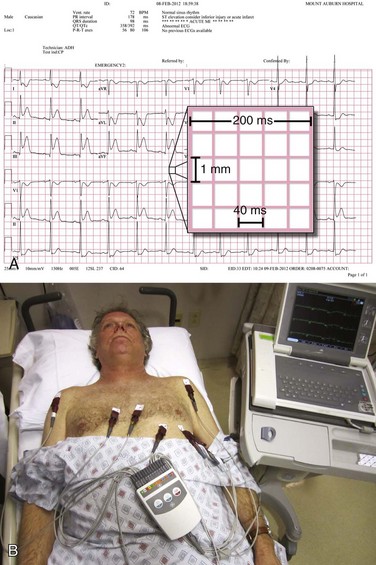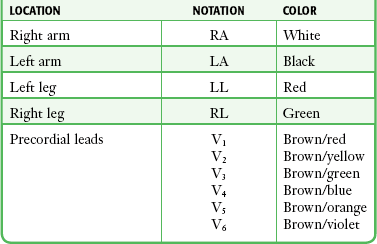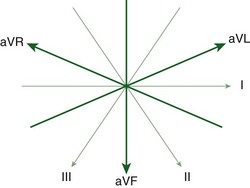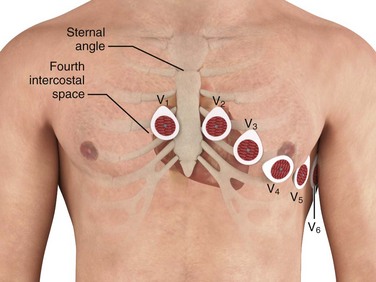Basic Electrocardiographic Techniques
Background
In 1903, Dutch physiologist Willem Einthoven1 first published his recordings of the cardiac cycle with a new device, the string galvanometer. Einthoven’s instrument consisted of a thin, silver-coated quartz filament stretched across a magnetic field. When an electrical current passed through the string, it caused movement from side to side. The filament was connected to electrodes placed on the limbs to measure differences in potential caused by the electrical activity of the heart. Einthoven magnified these measurements with a projecting microscope and recorded them photographically.2
Although others had previously recorded cardiac electrical activity, Einthoven’s instrument laid the basis for modern clinical electrocardiography. His work described the standard frontal-plane limb lead ECG using bipolar electrodes and established standards for recording rate and amplitude. In addition, he described five separate electrical deflections, which he termed P, Q, R, S, and T, thereby establishing the basic electrocardiographic nomenclature.3 Einthoven won the Nobel Prize in 1924 for his electrocardiographic recording machine, which has been called “probably the most sophisticated scientific instrument in existence when it was first invented.”4
Thomas Lewis visited Einthoven’s laboratory and recognized the potential clinical utility of the electrocardiography machine. Lewis became the leading authority on electrocardiography in the early 1900s and was instrumental in the development and clinical application of this new technology.2 Using the electrocardiographic machine, Lewis determined that atrial fibrillation was due to a “circus conduction” involving the auricle of the heart and published much of his clinical work on ECGs in his landmark texts “The Mechanisms of the Heart Beat” in 19115 and “Clinical Electrocardiography” in 1913.6
The development of smaller, portable bedside electrocardiographic recording machines after World War I led to the rapid dissemination and use of ECGs in the clinical setting. In the early 1930s, Francis Wood and Charles Wolferth first reported the use of ECGs to differentiate cardiac and noncardiac chest pain.2 Along with Frank Wilson, their work also led to development of the unipolar “exploring” electrode, which measured electrical activity anywhere in the body with a zero-potential central terminal as a reference. These electrodes could be placed directly over the chest and formed the basis for the standard precordial leads.7
In 1938, the American Heart Association in conjunction with the Cardiac Society of Great Britain established the standard six precordial chest lead positions (V1 to V6).8 These precordial leads, along with Einthoven’s original bipolar limb lead system (I, II, III) and the augmented unipolar limb leads developed by Emmanual Goldberger (aVR, aVL, and aVF) in 1942, make up the standard 12-lead ECG used today.
Indications
The most frequent indication for electrocardiography in the ED is the presence of chest pain. Other common indications include abnormal rhythm, palpitations, dyspnea, syncope, and diagnosis-based (e.g., acute coronary syndrome [ACS], suspected pulmonary embolism) and system-related (e.g., “rule out myocardial infarction [MI]” protocol, admission purposes, and operative clearance) indications.9 The ECG is used to help establish a diagnosis, select appropriate therapy, determine the response to treatment, assist in correct disposition of the patient, and help predict risk for both cardiovascular complication and death.
The initial 12-lead ECG obtained in the ED can be an important tool for determination of cardiovascular risk and, accordingly, the choice of in-hospital admission location. Brush and coworkers10 classified the initial ECG into high- and low-risk groups. The low-risk electrocardiographic group had normal ECGs, nonspecific ST-T-wave changes, or no change when compared with a previous ECG. High-risk ECGs had significant abnormalities or confounding patterns—such as pathologic Q waves, ischemic ST-segment or T-wave changes, left ventricular hypertrophy, left bundle branch block, or ventricular paced rhythms. Patients with initial ECGs classified as low risk had a 14% incidence of acute myocardial infarction (AMI), a 0.6% incidence of life-threatening complications, and a 0% mortality rate. Patients with initial ECGs classified as high risk had a 42% incidence of AMI, a 14% incidence of life-threatening complications, and a 10% mortality rate.10 Another approach to risk prediction involves simple calculation of the number of electrocardiographic leads with ST-segment deviation (elevation or depression)—with an increasing number of leads being associated with higher risk. Along similar lines, the clinician is also able to predict risk with a summation of the total millivolts of ST-segment deviation; once again, higher totals are associated with greater risk.10
The limitations of the ECG must be recognized, however. The ECG is widely reported to have a sensitivity for AMI of only approximately 55%; in one study of 1000 patients with ischemic symptoms, sensitivity improved to 68% with serial ECGs and monitoring of ST-segment trends.11 In another series, the sensitivity of the ECG for AMI ranged from 43% to 65% over a 12-hour period after the onset of ischemic symptom, yet the negative predictive value of a normal ECG (defined as normal or with nonspecific changes or isolated fascicular blocks) for AMI did not improve above 93% during this period.12 In a large series of more than 10,000 patients, in 889 (8%) of whom AMI was ultimately diagnosed, 19 (2%) were inappropriately discharged from the ED. A nonischemic ECG emerged as one of five risk factors for that inappropriate disposition decision (along with female gender, age <55 years, nonwhite race, and dyspnea as a chief complaint); 2 of those 19 had a normal tracing, whereas the other 17 had nonischemic findings on their ECGs.13
Basic Equipment
Although there is variability depending on the workplace, most ECGs in use today are three-channel recorders with computer memory. Such multichannel systems, which record electrical events in several leads concurrently, offer advantages over the antiquated single-channel recorder systems: capturing transient events on multiple leads simultaneously; banking the data in computer memory for storage, comparison, and transmission; and allowing presentation of data on a single sheet of paper.14 The electrocardiographic tracing is printed in a standardized manner on standardized paper by the electrocardiograph, which has default settings regarding the speed at which the paper moves through the machine, as well as the amplitude of the deflections to be made on the tracing (Fig. 14-1A). Electrocardiographic paper is divided into a grid with a series of horizontal and vertical lines; the thin lines are 1 mm apart, and the thick lines are separated by 5 mm. At the standard paper speed of 25 mm/sec, each vertical thin line thus represents 0.04 second (or 40 msec), and the thick vertical lines correspond to 0.20 second (or 200 msec). Recordings from each of the 12 leads are typically displayed for 2.5 seconds by default setting; the leads appearing horizontally adjacent to each other are separated by a small vertical hash mark to represent lead change.
The standard ECG includes 12 leads derived from 10 electrodes placed on the patient; each is color-coded and represented by a two-character abbreviation (Table 14-1; see also Fig. 14-1B). Placement of limb leads on the left and right arms (LA and RA, respectively) and the left and right legs (LL and RL, respectively) by color can be recalled with the help of several mnemonics, including the following: “Christmas trees below the knees (the green and red leads are placed on the lower extremities), “white on right and green to go” (the white lead is placed on the RA, the green lead is placed on the leg that controls the gas pedal, and the red lead is correspondingly placed on the leg that is closer to the brake), and “smoke over fire” (the black LA lead is placed over the red LL lead, as with telemetric monitoring pads). Use of these mnemonics may help prevent right/left confusion during electrode placement—and the consequences of limb electrode reversal and misinterpretation of the ECG (see “Electrode Misplacement and Misconnection” later in this chapter).
Standard 12 Leads
The standard 12-lead ECG depicts cardiac electrical activity from 12 points of view, or leads, that can be grouped according to planar orientation. Six leads (I, II, III, aVR, aVL, and aVF) are oriented in the frontal, or coronal, plane and derived from the four limb electrodes. The six precordial leads (V1, V2, V3, V4, V5, and V6) are oriented in the horizontal, or transverse, plane, with each representing cardiac electrical activity from that perspective. Leads I, II, and III are termed limb leads and are bipolar in that they record the potential difference between two electrodes (Fig. 14-2). The fourth electrode located on the right leg serves as an electrical ground. The positive poles of these bipolar leads lie to the left and inferior, a position approximating the major vector forces of the normal heart. This early convention was established so that the tracing would feature primarily upright complexes. In contrast, augmented leads aVR, aVL, and aVF are unipolar leads with the positive electrode located at the respective extremities. These augmented leads serve to fill the electrical gaps between leads I, II, and III. Lead aVR stands alone with a polarity and resultant orientation opposite that of the other limb and augmented leads because of the fact that its positive electrode is located in the opposite direction (superior and to the right) of the major vector force of the normal heart (inferior and to the left); thus its complexes usually appear “opposite” those in most or all of the other leads.
Merging of the vector axes of the limb and augmented leads around a central axis yields a hexaxial system representing cardiac electrical activity in the frontal plane (Fig. 14-3). The six precordial leads, oriented in the horizontal plane, represent six unipolar electrodes with vector positivity oriented toward the chest surface and the central terminal of the hexaxial system serving as a negative pole. In contrast to the frontal-plane leads, the angles between each of the precordial leads in the horizontal plane are not equal. They can vary depending on electrode placement and body habitus.
Electrode Placement
The four limb electrodes are conventionally placed on the extremities as follows: RA on the right wrist, LA on the left wrist, RL on the right ankle, and LL on the left ankle. Electrodes may be affixed more proximally on the limbs if necessary (e.g., amputation, severe injuries), ideally with a notation made on the ECG.15 Others note that the electrodes may be placed on any part of the arms or legs, provided that they are distal to the shoulders or inguinal/gluteal folds, respectively.16
Mason-Likar electrode placement is commonly used by hospital staff and paramedics; this approach does not alter precordial electrode placement but instead moves the limb electrodes to the torso. Originally described in 1966, the Mason-Likar configuration differs from standard electrode placement in that the arm electrodes are relocated to the infraclavicular fossae (medial to the borders of the deltoid muscles and 2 cm below the clavicles) and the leg electrodes are positioned along the anterior axillary lines (halfway between the costal margins and the iliac crests). Actual torso positioning may differ in practice because of individual variation or an attempt to simulate limb electrode placement. A rightward frontal-plane access shift has been described when torso electrode placement is used for the limb electrodes instead of standard positioning on the extremities. Mason-Likar positioning has also been associated with diminution of inferior Q waves, thus making detection of inferior MI more difficult.17 An alternative electrode configuration is the Lund system, in which the arm electrodes are placed laterally on the left and right arms at the level of the axillary folds and the leg electrodes are positioned laterally on the major femoral trochanters. The Lund system has been found to more directly approximate the electrocardiographic recordings obtained with conventional positioning than the Mason-Likar configuration does.18,19
The precordial electrodes should be placed as follows: V1—right sternal border, fourth intercostal space; V2—left sternal border, fourth intercostal space; V3—midway between V2 and V4; V4—left midclavicular line, fifth intercostal space; V5—left anterior axillary line, same horizontal level as V4; and V6—left midaxillary line, same horizontal level as V4 and V5 (Fig. 14-4). Note that V4 to V6 are placed at the same horizontal level, not all in the fifth intercostal space. If V5 and V6 are situated so that they follow the contour of the intercostal space rather than being on the same horizontal level, they will be superiorly displaced as the ribs curve around the side of the thorax. Minor changes in the position of the precordial leads will alter the ECG tracing, so it is important to keep the adhesive leads in place throughout the ED stay so that lead placement is identical during serial ECG comparisons.
Intercostal space number can be determined by first palpating the sternal angle (angle of Louis), which is the junction of the manubrium and body of the sternum (see Fig. 14-4). This transverse bony ridge is located about 5 cm caudad from the sternal notch in adults. Immediately lateral and inferior to it is the second intercostal space; two spaces farther down lies the fourth intercostal space, where V1 and V2 should be placed. Alternatively, one can count down from the medial aspect of the clavicle; beneath the clavicle lies the first rib, below which is the first intercostal space. The precordial electrodes should not be simply “eyeballed” by the technician because as little as 1 to 2 cm of electrode displacement can result in significant morphologic alteration in the precordial QRS complexes.17,20
If the patient’s anatomy or injury precludes placement of a precordial electrode as just described, it is permissible to attach it within the radius of the width of one interspace of the recommended position, with appropriate notation on the tracing. If the situation demands further displacement, it is recommended that the lead be omitted, with appropriate documentation on the tracing.15
A recent study compared conventional 12-lead electrocardiography with the use of disposable, prewired electrodes linked together and placed on the precordium and torso in a manner similar to Mason-Likar positioning. The prewired device saved time (median, 25 seconds, or 20% faster) and featured significantly less artifact than did the conventional method—at four times the cost, however. Only a slight shift in the mean QRS axis was noted (6 degrees when comparing group means).21
Pediatric Electrode Placement
In addition to the standard 12-lead tracing, leads V4R and V3R should also be recorded; these are mirror images of their left-sided counterparts (see “Additional Leads” later in this chapter). The chest of a tiny infant may not accommodate all the precordial electrodes; in such cases the following array is recommended: V3R or V4R, V1, V3, and V6. Limb electrode placement is the same as in adults.22
Features of the ECG
Information Provided by the Computer
In addition to the patient demographic data entered by the operator, the tracing will often feature computations regarding rate, intervals, and axes along the top of the paper. On some tracings a computer-generated “reading” will also be displayed at the top of the tracing. These interpretations are not infallible. A sample of nine of these programs was compared with the readings of eight cardiologists; the “gold standard” in this study was clinical diagnosis made independently of the interpretations of these tracings based on other objective data (e.g., echocardiography, cardiac catheterization). The performance of the programs was good, with correct interpretations in a median of 91% of cases, but the cardiologists were significantly better (median of 96% correct).23 The computer programs demonstrated a median sensitivity for anterior and inferior MI of only 77% and 59%, respectively.23 Of note, this study did not evaluate interpretation of acute ischemia and cardiac rhythm disturbance—perhaps the most critical issues in electrocardiographic interpretation. Others have found both the computer programs and clinicians to be lacking in their ability to exclude cardiac disease with the ECG, with a negative predictive value for each of between 80% and 85%.24 When diagnosing atrial fibrillation, both general practitioners (sensitivity, 80%; specificity, 83%) and computer software (sensitivity, 83%; specificity, 99%) are flawed; when combined, diagnostic accuracy improves but is still imperfect (sensitivity, 92%; specificity, 91%).25
Adjustable Features
Somewhere on the tracing—usually in the left lower corner of the recording—notation of electrocardiographic paper speed (in millimeters per second), calibration (in millimeters per millivolt), and the frequency response (in hertz) will be evident. Calibration, or standardization, refers to the amplitude of the waveforms on the tracing. It is usually set at a default value of 10 mm/mV and is graphically depicted by a plateau-shaped waveform that appears at the extreme left side of the tracing, in front of the first complex (Fig. 14-5A). This calibration can be modified by the operator or by the computer itself, as was the case in Figure 14-5B, in which the patient appeared to have acquired voltage criteria for left ventricular hypertrophy when in reality the tracing was unchanged from his baseline (see Fig. 14-5A). Increasing the calibration to 20 mm/mV is helpful when trying to decipher P-wave morphology. Decreasing the calibration to 5 mm/mV is helpful in cases in which the amplitude of the QRS complex (usually in the precordial leads) is so large that it encroaches on those of adjacent leads. Standardization may not be uniform throughout a given tracing. At times, calibration will be automatically adjusted by the computer based on the waveform amplitudes that it perceives. For example, it is possible to have normal calibration (10 mm/mV) in the limb and augmented leads with half-standard calibration in the precordial leads (5 mm/mV). This may occur in instances of marked left ventricular hypertrophy. In this case the calibration pulse at the left-hand side of the paper will have a downward stairstep appearance.
Paper speed is usually set at a default of 25 mm/sec. It may be manipulated for purposes of deciphering a dysrhythmia, as described later (see “Alteration in Amplitude and Paper Speed”). It is important that the clinician examine all electrocardiographic tracings for standardization and paper speed parameters before rendering an interpretation.
Additional Leads
15-Lead ECG
In a study of all ED patients with chest pain, Brady and associates26 reported that the 15-lead ECG provided a more accurate description of myocardial injury in patients with AMI yet failed to alter rates of diagnosis or use of reperfusion therapies or to change disposition locations. Looking at a more selected population of ED patients, Zalenski and colleagues27













